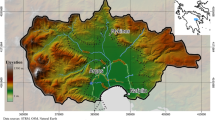Abstract
Long-term time series data of aquifer recharge, groundwater extraction, and discharge are used to estimate aquifer storage capacity and maximum annual yield. Aquifer storage capacity is defined as the maximum volume of water that can be stored in an aquifer. It is estimated using a transient water-balance approach. The maximum annual yield is defined as the maximum combined groundwater extraction plus discharge that can be sustained in an aquifer judged by the historical record of recharge. It is determined according to a graphical mass-curve method. These two quantities are useful in aquifer characterization and groundwater management, the apportionment of groundwater rights and aquifer storage and recovery operations being two frequent applications. Time series data from the Edwards Aquifer, Texas, USA, illustrate the application of the methods presented.
Résumé
Des données sur le long terme de la recharge d’aquifère, de l’exploitation de l’eau souterraine et de la vidange sont utilisées pour estimer la capacité d’emmagasinement de l’aquifère et la capacité annuelle maximum. La capacité d’emmagasinement de l’aquifère est définit comme le volume maximum de l’eau qui peut être emmagasinée dans le réservoir. Elle est estimée en utilisant une approche par bilan hydrologique en transitoire. La capacité annuelle maximum est définit comme la combinaison de l’extraction de l’eau souterraine et de la vidange, combinaison qui peut être jugée durable ou non au regard de l’examen des valeurs de recharge. Elle est déterminée au moyen d’une méthode de courbe des valeurs cumulées. Ces deux quantités sont très utiles pour caractériser les aquifères et pour gérer les eaux souterraines, l’imputation des droits aux eaux souterraines, et du fait que les opérations de recharge des aquifères et de récupération sont très fréquentes. Les données temporelles provenant de l’aquifère Edwards, Texas, USA, illustrent l’application de la méthode présentée.
Resumen
Para estimar la capacidad de almacenamiento de un acuífero y su rendimiento máximo anual, se han utilizado series temporales largas de datos de recarga al acuífero, de extracciones de agua subterránea y de descarga. La capacidad de almacenamiento de un acuífero se define como el volumen máximo de agua que puede ser almacenado en el mismo. Se estima utilizando una aproximación con un balance de agua en régimen transitorio. El rendimiento máximo anual se define como el máximo resultante de la combinación de la extracción de aguas subterráneas y la descarga que puede ser sostenido por un acuífero según los registros históricos de recarga y se define según un método gráfico masa-curva. Estos dos valores son útiles en la caracterización de los acuíferos y en la gestión de las aguas subterráneas, el reparto de los derechos sobre las aguas subterráneas y las operaciones de almacenaje y recuperación de los acuíferos, que son dos aplicaciones frecuentes. Las series de tiempo para el Acuífero Edwards, Texas, USA, ilustra la aplicación de los métodos presentados.




Similar content being viewed by others
References
Alley WM, Leake SA (2004) The journey from safe yield to sustainability. Ground Water 42(1):12–16
Alley WM, Reilly TE, Franke OL (1999) Sustainability of groundwater resources. United States Geological Survey Circular 1186, US Geological Survey, Denver, CO
Devlin JF, Sophocleous M (2005) The persistence of the water budget myth and its relationship to sustainability. Hydrogeol J 13:549–554
Edwards Aquifer Authority, San Antonio, Texas (2006) The Edwards Aquifer. http://edwardsaquifer.org/. Accessed 26 December 2007
Fetter CW (2001) Applied Hydrogeology, 4th edn. Prentice Hall, Englewood Cliffs, NJ
Heath RC (1987) Basic Ground-Water Hydrology. US Geol Surv Water Suppl Pap 2220, 84 pp
Linsley RK, Franzini JB (1979) Water resources engineering, 3rd edn. McGraw-Hill, New York
Loáiciga HA (2003) Sustainable groundwater exploitation. Int Geol Rev 44(12):1115–1121
Loáiciga HA (2006) Comment on “The persistence of the water budget myth and its relationship to sustainability” by JF Devlin and M Sophocleous, Hydrogeology Journal, 13, 549–554, 2005. Hydrogeol J 14:1383–1385
Loáiciga HA, Wolf J (2007) Long-term recharge, groundwater extraction, and aquifer-spring interactions in a regional karst aquifer. In: Ground water and ecosystems, Proceedings of the XXXV International Association of Hydrogeologists (IAH) Congress, Lisbon, Portugal, 17–21 September, p 8
Loáiciga HA, Haston L, Michaelsen J (1993) Dendrohydrology and long-term hydrologic phenomena. Rev Geophys 31(2):151–171
Loáiciga HA, Maidment D, Valdes JB (2000) Climate change impacts in a regional karst aquifer, Texas, USA. J Hydrol 227:173–194
Maclay RW, Small TW (1984) Carbonate geology and hydrogeology of the Edwards Aquifer, San Antonio area, Texas. US Geol Surv Open File Rep 83–537, 72 pp
Puente CA (1978) A method of estimating natural recharge to the Edwards Aquifer in the San Antonio area, Texas. US Geol Surv Water Resour Invest Rep 78–10, 34 pp
Theis CV (1940) The source of water derived from wells, essential factors controlling the response of an aquifer to development. Civ Eng 10(5):277–280
Zektser IS, Loáiciga HA, Wolf J (2005) Environmental impacts of ground-water overdraft: selected case studies in the southwestern United States. J Environ Geol 47(3):396–404
Acknowledgements
This article was prepared with support from the University of California Water Resources Center through grant WR-2007–09 to research the impacts of modern-age global warming on aquifers.
Author information
Authors and Affiliations
Corresponding author
Rights and permissions
About this article
Cite this article
Loáiciga, H.A. Aquifer storage capacity and maximum annual yield from long-term aquifer fluxes. Hydrogeol J 16, 399–403 (2008). https://doi.org/10.1007/s10040-007-0270-1
Received:
Accepted:
Published:
Issue Date:
DOI: https://doi.org/10.1007/s10040-007-0270-1




